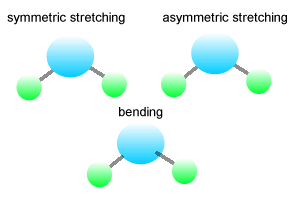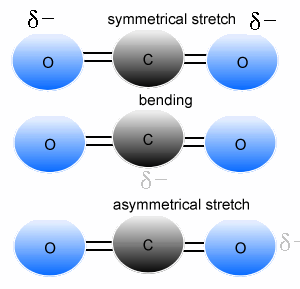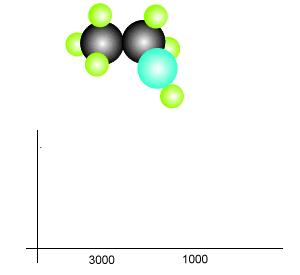Molecules are not rigid, inflexible structures but can bend and stretch in many different ways, as the image of a water molecule shows on the right.
IR radiation is absorbed by the bonds of a molecule when the stretching and bending of each bond yields a change in the dipole moment of the molecule. When the electromagnetic radiation interacts with the changing dipole moment of the bond, IR radiation is absorbed.

Molecules such as Cl2 are IR inactive because they have no dipoles. Carbon dioxide, for example, although symmetrical, is IR active. When its bonds undergo an asymmetric stretch or bend the dipole moment of the molecule changes at a certain rate per second, known as its frequency measured in Hz. If this changing dipole frequency matches a frequency in the IR electromagnetic region then absorption of that particular IR frequency takes place. You will notice that IR absorption spectra graph absorbance or transmittance against wavenumber, on the X-axis. Frequency and wave number are related but the explanation is beyond the scope of this course.
Notice in the animation on the right how a symmetrical stretch does not change the dipole moment of the molecule and hence this particular vibration is IR inactive.

Click to see a few ways in which molecules can stretch and bend along their covalent bonds. When a molecule absorbs infrared radiation and stretches or bends its dipole moment changes, as depicted in the animation.
The wavelength or frequency that the bond is capable of absorbing depends on the strength of the bond and the mass of the atoms forming the bond. The heavier the atoms involved in the bond, the lower the absorption frequency, assuming a constant bond strength.
Infrared radiation has a longer wavelength and is less energetic than UV and visible light. Click to see where infrared radiation lies in the electromagnetic spectrum. This type of radiation is not powerful enough to promote electrons to higher energy orbits but is capable of causing covalent bonds to bend and stretch. IR is a nondestructive investigation of organic material, even living tissue. All it does is make molecules vibrate in a way that information about the molecule can be gained. Given that it is a nondestructive technique, it has the advantage of being able to identify trace amounts of substances without destroying vital evidence. Even allowing identification to be performed through a glass or plastic container.
Before we discuss
how an infrared spectrophotometer works
lets look at the molecular structure of ethanol and how it generates an
IR spectrum. You will notice that ethanol has a number of different types
of covalent bonds, namely:
- C-C;
- C-O;
- O-H;
- C-H.
Over a narrow band, different wavelengths of energy will be absorbed depending
on the nature of the covalent bond. As you can see from the animation
on the right each bond has its characteristic wavelength which it absorbs
in order to stretch or bend.
The frequency of the stretching vibration depends on two factors:
(1) The mass of the atoms
(2) The strength or stiffness of the bond
Bonds containing heavier atoms vibrate more slowly than lighter ones. A carbon-oxygen (C-O) bond will vibrate at a lower frequency than a carbon-hydrogen (C-H) bond.
Stronger bonds hold the atoms more tightly and so require more force to stretch or compress them, therefore stronger bonds, such as a oxygen-hydrogen (O-H), generally vibrate at higher frequencies than weaker bonds such as carbon-hydrogen (C-H) bonds.
Of course the array of wavelengths absorbed depends on the bonds that are found in the entire molecular structure and therefore an IR spectrum can be considered as a molecular fingerprint capable of identifying a particular molecule. In order to identify molecules using IR spectroscopy , spectra are matched, by computer, to the tens of thousands already present in a data base.

A video of IR spectroscopy can be viewed on the right.
The frequency of radiation absorbed by a bond is determined by
IR spectroscopy can assist in identifying the